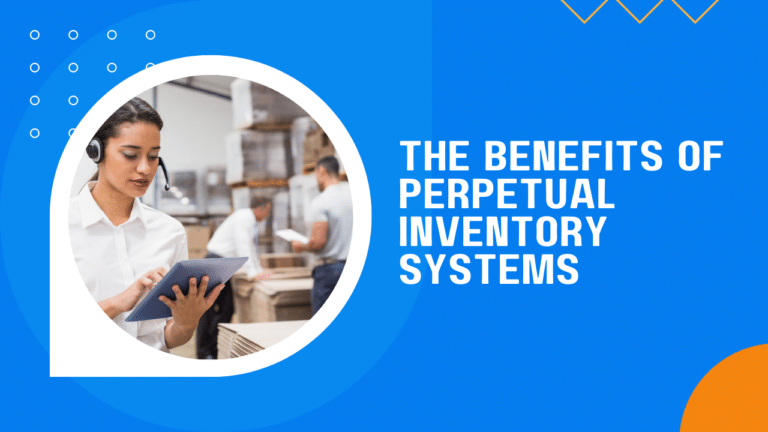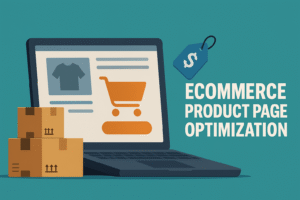For an ecommerce business, managing inventory efficiently stands as a cornerstone of success. As online sales continue to surge, businesses face the ever-growing challenge of keeping up with the demands of real-time inventory management—a task that traditional methods are increasingly unable to support.
Enter perpetual inventory systems, a modern solution designed to revolutionize how ecommerce businesses track and manage their stock. These systems offer a dynamic approach by providing up-to-the-minute accuracy in inventory levels, thereby enabling businesses to make informed decisions, reduce costs, and ultimately enhance customer satisfaction.
By leveraging the power of technology, perpetual inventory systems seamlessly integrate with sales and purchasing processes, ensuring that inventory data is always current and accurate.
Whether you’re a seasoned ecommerce entrepreneur or new to the digital marketplace, understanding how to optimize your inventory management with a perpetual inventory system can be a game-changer in driving your business forward.
Understanding Perpetual Inventory Systems
These systems, unlike their traditional counterparts, offer a real-time view of inventory, seamlessly updating stock levels with every sale and restock. But what exactly are perpetual inventory systems, and how do they operate to provide such pivotal benefits? This section delves into the definition, workings, and advantages of perpetual inventory systems, laying the foundation for their significance in ecommerce.
Definition and Overview
A perpetual inventory system is a method of inventory management that records the sale or purchase of inventory immediately through the use of computerized point-of-sale systems and enterprise asset management software. This contrasts sharply with periodic inventory systems, where inventory counts are updated at set intervals, often leading to discrepancies between actual stock levels and recorded figures.
By maintaining a continuous, real-time record of inventory, perpetual systems ensure that a business’s stock data is always current, thereby facilitating more accurate and efficient management practices.
How It Works
At its core, a perpetual inventory system integrates with various components of a business’s operational software — from point-of-sale (POS) systems to ecommerce platforms and accounting software. When a product is sold, the system automatically deducts the item from the inventory count, simultaneously updating the accounting records to reflect the sale.
Similarly, when new stock is received, inventory levels are instantly updated. This integration extends to order management and supply chain operations, allowing businesses to automate reorder points, track inventory across multiple locations, and even forecast demand based on historical data.
The system’s real-time nature offers several key advantages:
- Visibility: Business owners and managers can view accurate inventory levels at any time, without waiting for periodic counts.
- Accuracy: Automated updates reduce the risk of human error in inventory counts and record-keeping.
- Efficiency: The immediate recording of transactions streamlines inventory management, making it easier to respond to stock needs swiftly.
The ability to track inventory accurately and in real-time not only supports operational efficiency but also enhances decision-making, ultimately leading to improved customer satisfaction and business growth.
The Importance of Perpetual Inventory Systems for Ecommerce
The shift towards ecommerce has intensified the need for businesses to adopt more efficient and accurate inventory management systems. Perpetual inventory systems stand out as a crucial technology for ecommerce operations, offering a myriad of benefits that cater to the unique demands of online retail.
Real-time Inventory Tracking
One of the primary advantages of perpetual inventory systems is their ability to provide real-time updates on stock levels. For ecommerce businesses, where inventory can change by the minute due to online orders, this feature is indispensable.
Real-time tracking eliminates the guesswork and delays associated with periodic inventory counts, ensuring that the available stock information is always accurate and up to date. This immediacy allows businesses to maintain optimal stock levels, preventing both overstocking and stockouts, which can significantly impact customer satisfaction and sales.
Improved Accuracy and Efficiency
Perpetual inventory systems automate the process of tracking sales and replenishments, significantly reducing the potential for human error that comes with manual record-keeping. This automation ensures that inventory records are always accurate, which is vital for maintaining customer trust and operational efficiency.
Moreover, the efficiency gained from automation allows staff to redirect their focus from tedious inventory management tasks to more strategic activities, such as customer service or growth initiatives, further enhancing business performance.
Enhanced Decision Making
The detailed and accurate data provided by perpetual inventory systems empower business owners and managers to make informed decisions. Access to real-time inventory information facilitates better planning and forecasting, enabling businesses to adjust their purchasing strategies based on current trends and demand.
Additionally, the integration of inventory data with other business systems, such as sales analytics and financial reporting, provides a comprehensive view of the business’s operational health, guiding strategic decisions that drive growth and profitability.
Cost Savings
Implementing a perpetual inventory system can lead to significant cost savings for ecommerce businesses. By maintaining accurate stock levels, businesses can avoid the costs associated with overstocking, such as excess storage fees, and reduce the risk of lost sales due to stockouts.
The efficiency improvements and time savings realized through system automation can reduce labor costs and increase productivity, contributing to the overall financial health of the business.
Implementing a Perpetual Inventory System in Ecommerce
The transition to a perpetual inventory system represents a significant leap forward in how ecommerce businesses manage their stock. This shift, however, requires careful planning and execution to ensure success.
From selecting the right software to training your team, the implementation process is crucial. This section outlines the essential steps and best practices for integrating a perpetual inventory system into an ecommerce operation, ensuring a smooth transition and maximum efficiency.
Key Features to Look For
Selecting the right perpetual inventory system is foundational to the implementation process. Essential features to consider include:
- Integration Capabilities: The system should seamlessly integrate with your existing ecommerce platform, accounting software, and any other relevant operational tools.
- Real-Time Tracking: Essential for accurate, up-to-the-minute inventory management.
- User-Friendly Interface: Ensures that your team can efficiently navigate and utilize the system.
- Reporting and Analytics Tools: For generating actionable insights from inventory data, aiding in strategic decision-making.
- Scalability: The system should be able to grow with your business, accommodating increased inventory, more users, or additional sales channels without significant upgrades.
Steps for Implementation
- Selecting a Software Provider: Research and compare different systems, focusing on the features mentioned above. Consider reaching out to other ecommerce businesses for recommendations and reading online reviews.
- System Integration: Work with the software provider to integrate the new system with your existing platforms. This may involve migrating data from your old system to the new one.
- Data Migration and Auditing: Before going live, ensure all existing inventory data is accurately transferred to the new system. Conduct a thorough audit to verify accuracy.
- Staff Training: Organize training sessions for your team to familiarize them with the new system. Ensure they understand how to perform daily inventory tasks and analyze reports.
- Setting Up Processes: Establish clear procedures for managing inventory within the new system, including receiving new stock, processing sales, and conducting regular audits.
- Going Live and Monitoring: Once the system is live, monitor its performance closely. Be prepared to address any issues or questions that arise.
Best Practices for a Smooth Transition
- Start Small: If possible, consider implementing the system in stages, starting with a single product line or location to iron out any kinks before a full rollout.
- Engage Your Team Early: Involving your team early in the process helps ensure buy-in and can provide valuable insights into the system’s practicality and usability.
- Maintain Open Communication: Keep lines of communication open with your software provider and within your team to quickly address any concerns or issues.
- Schedule Regular Check-ins: After implementation, schedule regular meetings to discuss the system’s performance, any challenges faced, and potential improvements.
By carefully selecting the right system, preparing your team, and following a structured implementation process, your business can leverage the full benefits of perpetual inventory management, setting the stage for enhanced operational success and growth.
Conclusion
The implementation and utilization of perpetual inventory systems in ecommerce operations mark a pivotal advancement in how businesses manage their inventory. The transition to a perpetual inventory system offers a myriad of benefits, from real-time tracking and improved accuracy to enhanced decision-making and significant cost savings. These systems not only streamline inventory management processes but also provide ecommerce businesses with the agility and efficiency required to thrive in the competitive digital marketplace.
The adoption of perpetual inventory systems enables businesses to maintain optimal stock levels, reduce the risk of stockouts and overstocking, and ultimately improve customer satisfaction. By leveraging the power of real-time data, ecommerce businesses can make informed decisions, forecast demand more accurately, and adjust their strategies in response to market changes. Furthermore, the cost savings realized through improved efficiency and reduced manual labor contribute to a healthier bottom line.
.
4. Implementing a Perpetual Inventory System in Ecommerce
Key Features to Look for
List essential software features necessary for effective implementation, such as integration capabilities, user interface, and reporting tools.
Steps for Implementation
Provide a step-by-step guide on implementing a perpetual inventory system, from selecting a provider to integrating it with current systems.
Best Practices for a Smooth Transition
Offer tips on ensuring a seamless transition, including conducting inventory audits and training staff.
5. Case Studies and Success Stories
Present examples of ecommerce businesses that have benefited from adopting a perpetual inventory system, focusing on the challenges they faced and the outcomes.
6. Choosing the Right Perpetual Inventory System for Your Business
Factors to Consider
Discuss how business size, budget, and specific needs influence the choice of system.
How to Research and Select a Software Provider
Provide advice on evaluating and choosing the right software solution, including recommendations for research and selection criteria.
7. Conclusion
Summarize the key points made throughout the article.
Reinforce the importance of perpetual inventory systems in optimizing ecommerce operations.
Include a call to action, encouraging readers to evaluate their current inventory management system and consider the transition to a perpetual inventory system.
8. Call to Action (CTA)
Prompt readers to take the next step towards optimizing their inventory management by researching perpetual inventory systems suited to their business needs.









